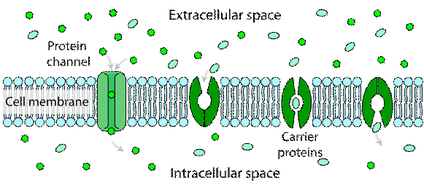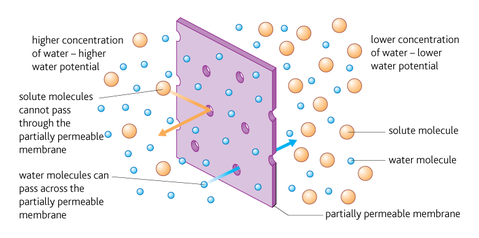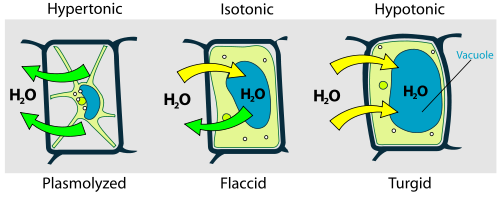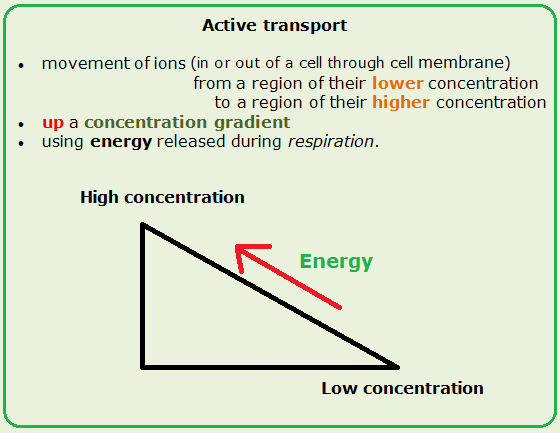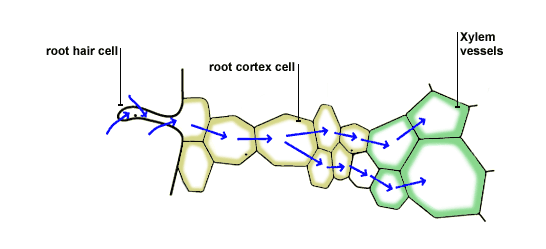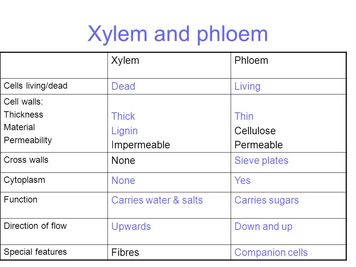topic 5: transport in plants
 image from gleamsofsunshine.com
image from gleamsofsunshine.com
The driving force behind water movement in plants is evaporation through the leaves, which acts like a magnet pulling water up the plant’s plumbing system. However, because water is evaporating from a living surface, it is called transpiration. The problem is that plants want to hold onto their water and not let it all out through transpiration. Therefore plants are constantly struggling to hang on to their water.
Identify the concepts of diffusion, osmosis and active transport as the main processes of substance exchange across membranes.
- Identify: Provide an answer from a number of possibilities. Recognize and state briefly a distinguishing fact or feature.
Molecules are in constant motion, and through diffusion spread out evenly to take up whatever space is available to them. Of course water molecules diffuse too, but in living things water often diffuses across a membrane. This process is called osmosis. Water moves in and out of cells through osmosis, and always moves from regions of high concentration to regions of low concentration. Water concentration is different than solute concentration, which refers to the stuff dissolved in the water, and keeping those two concepts straight is necessary to figure out where water will go inside a plant
Water potential is the property of water that determines which way it will flow, which depends on the concentration of solutes in the water and the pressure being exerted on the water. Another way to think about this is the water’s capacity to move or do work. Water potential measures the concentration of free water molecules. It is a measure of the tendency of these molecules to diffuse to another area. The more free water molecules, the higher the water potential.
Water diffuses by osmosis from a region of high water potential to a region of low water potential through the water potential gradient. Osmosis can therefore be defined as the diffusion of water from a region of high water potential to a region of low water potential through a partially permeable membrane.
Water diffuses by osmosis from a region of high water potential to a region of low water potential through the water potential gradient. Osmosis can therefore be defined as the diffusion of water from a region of high water potential to a region of low water potential through a partially permeable membrane.
Describe the relationship between osmosis, energy, and water potential.
- Describe: Give a detailed account or picture of a situation, event, pattern or process.
Pressure potential is the amount of force being exerted on a solution. In living cells, this pressure comes from the contents of the cell pushing against the cell wall. The cell wall pushes back, causing turgor pressure. Turgor pressure causes plant parts to be firm and erect.
Discuss the importance in plants of turgid cells as a means of support
- Offer a considered and balanced review that includes a range of arguments, factors or hypotheses. Opinions or conclusions should be presented clearly and supported by appropriate evidence.
When a plant cell loses turgor pressure, the solution the cell is in is hypertonic and the cell is plasmolyzed, which means water leaves the cell and the cell membrane shrinks. If water enters the cell at the same rate it leaves the cell, the cell is flaccid (and the solution is isotonic). When water enters the cell and pushes on the cell wall, the cell is turgid (and the solution is hypotonic).
Identify how the plant takes up in the roots
- Identify: Provide an answer from a number of possibilities. Recognize and state briefly a distinguishing fact or feature.
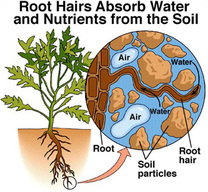 image from student.kc.school.nz
image from student.kc.school.nz
Water and minerals move into a plant through its roots. Near the tip of each branch of a root, there are thousands of tiny root hairs. These root hairs explore the soil to maximize the surface area within the soil profile. Water from the soil moves into these hairs byosmosis. The small size and large number of root hairs gives them an enormous surface area. So a lot of water can get into the plant very quickly.
Explain why some plants may die when their roots are submerged, that is, flooded, for long periods of time.
- Explain: Give a detailed account including reasons or causes.
Plants need water. This basic fact is known to everyone, regardless of gardening experience. What some people do not know is that giving a plant too much water can do more damage than not giving it enough.
Because plants do not have lungs to deliver oxygen to their cells, they must get it from the soil. Too much water in the soil layer forces air from the root zone, reducing the plant’s oxygen supply. This important oxygen is needed for the production of energy.
Because plants do not have lungs to deliver oxygen to their cells, they must get it from the soil. Too much water in the soil layer forces air from the root zone, reducing the plant’s oxygen supply. This important oxygen is needed for the production of energy.
Identify how the plant takes up minerals in the root
- Identify: Provide an answer from a number of possibilities. Recognize and state briefly a distinguishing fact or feature.
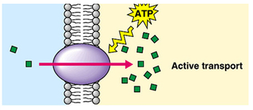
Mineral ions are dissolved in the water. These include nitrate, phosphate, calcium and magnesium ions. These also enter the root hairs. They travel into the plant dissolved in the water. cannot be absorbed by osmosis because this is the movement of water only. They cannot be absorbed by diffusion, because the minerals are in very low concentration. Instead, active transport is used.
The root hair cells have carrier molecules on their cell membranes. These pick up the mineral ions and move them across the membrane into the cell against the concentration gradient. Remember that substances move down a concentration gradient in diffusion, so active transport is quite different. Active transport needs energy from respiration to happen.
The root hair cells have carrier molecules on their cell membranes. These pick up the mineral ions and move them across the membrane into the cell against the concentration gradient. Remember that substances move down a concentration gradient in diffusion, so active transport is quite different. Active transport needs energy from respiration to happen.
Describe how water and minerals move upward through the xylem and how water balance keeps plants upright.
- Describe: Give a detailed account or picture of a situation, event, pattern or process.
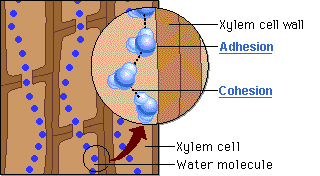
The xylem tissue transports water and minerals. It consists of interconnected vessels and tracheids organized into continuous conducting tubes stretching from the roots to the leaves. These tubes carry water and minerals to all parts of the plant. Evaporation from the mesophyll cells produces a negative water potential gradient that causes water and minerals to move upwards from the roots through the xylem.
Identify the structure of phloem and xylem and identify other functions of the transport system
- Identify: Provide an answer from a number of possibilities. Recognize and state briefly a distinguishing fact or feature.
Phloem and xylem are complex tissues that perform transportation of food and water in a plant. They are the vascular tissues of the plant and together form vascular bundles. They work together as a unit to bring about effective transportation of food, nutrients, minerals and water
Explain the process of transpiration and identify the transpiration streams as a means of water transport in vascular plants.
- Explain: Give a detailed account including reasons or causes
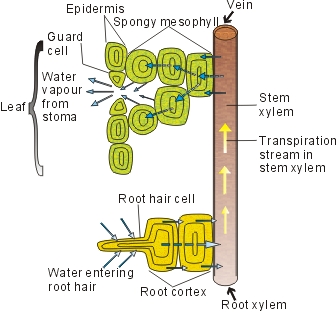 image from www.keihau.edu.hk
image from www.keihau.edu.hk
Plants lose gallons of water every day through the process of transpiration, the evaporation of water from plants through pores in their leaves. Up to 99% of the water absorbed by roots is lost via transpiration through plant leaves. This water loss allows the plant to access CO2 for photosynthesis and to cool itself.
Transpiration explains how water moves up the plant against gravity in tubes made of dead xylem cells without the use of a pump.
Water on the surface of spongy and palisade cells (inside the leaf) evaporates and then diffuses out of the leaf. This is called transpiration. More water is drawn out of the xylem cells inside the leaf to replace what's lost. As the xylem cells make a continuous tube from the leaf, down the stem to the roots, this acts like a drinking straw, producing a flow of water and dissolved minerals from roots to leaves.
When water is scarce, or the roots are damaged, it increases a plant’s chance of survival if the transpiration rate can be slowed down. Plants can do this themselves by wilting, or it can be done artificially, like removing some of the leaves from cuttings before they have chance to grow new roots.
Transpiration explains how water moves up the plant against gravity in tubes made of dead xylem cells without the use of a pump.
Water on the surface of spongy and palisade cells (inside the leaf) evaporates and then diffuses out of the leaf. This is called transpiration. More water is drawn out of the xylem cells inside the leaf to replace what's lost. As the xylem cells make a continuous tube from the leaf, down the stem to the roots, this acts like a drinking straw, producing a flow of water and dissolved minerals from roots to leaves.
When water is scarce, or the roots are damaged, it increases a plant’s chance of survival if the transpiration rate can be slowed down. Plants can do this themselves by wilting, or it can be done artificially, like removing some of the leaves from cuttings before they have chance to grow new roots.
Outline that the stomata controls the movement of gasses into and out of the leaf.
- Outline: Give a brief account or summary.
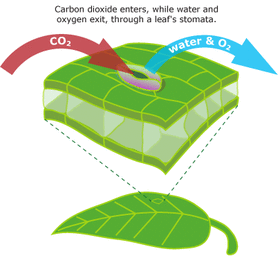 image from evolution.berkeley.edu
image from evolution.berkeley.edu
Stomata are essential to plants, since they take up gas that is used in photosynthesis. But since they are passageways into the plant’s insides, plants have to be able to control the opening and closing of the stomata. Plants only open their stomata when they need to, and politely close them when they don’t. They weren’t raised in a barn. Plants can lose a lot of water via evaporation through the stomata, and open stomata also provide pathogens with a means for entering the plant
Describe the factors that regulate the rate of transpiration.
- Describe: Give a detailed account or picture of a situation, event, pattern or process.
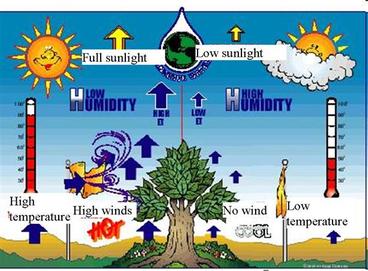 image from www.tankonyvtar.hu
image from www.tankonyvtar.hu
The amount of water that plants transpire varies greatly geographically and over time. There are a number of factors that determine transpiration rates:
- Temperature:Transpiration rates go up as the temperature goes up, especially during the growing season, when the air is warmer due to stronger sunlight and warmer air masses. Higher temperatures cause the plant cells which control the openings (stoma) where water is released to the atmosphere to open, whereas colder temperatures cause the openings to close.
- Relative humidity: As the relative humidity of the air surrounding the plant rises the transpiration rate falls. It is easier for water to evaporate into dryer air than into more saturated air.
- Wind and air movement: Increased movement of the air around a plant will result in a higher transpiration rate. This is somewhat related to the relative humidity of the air, in that as water transpires from a leaf, the water saturates the air surrounding the leaf. If there is no wind, the air around the leaf may not move very much, raising the humidity of the air around the leaf. Wind will move the air around, with the result that the more saturated air close to the leaf is replaced by drier air.
- Soil-moisture availability: When moisture is lacking, plants can begin to senesce (premature ageing, which can result in leaf loss) and transpire less water.
- Type of plant: Plants transpire water at different rates. Some plants which grow in arid regions, such as cacti and succulents, conserve precious water by transpiring less water than other plants.
Key Terms:
|
water potential gradient
partially permeable active transport passive transport transpiration stream selectively permeable turgid |
respiration
diffusion flaccid plasmolysed absorption mineral ion |
stomata
osmosis wilt hypotonic humidity simple diffusion |
transpiration
diffusion hypertonic isotonic root hair vascular bundle guard cells |
xylem
turgor transport phloem adaptation potometer gas exchange |
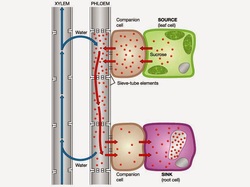
Classroom Material:
Evaporation From Leaves practical
Pearson Lab Bench
Transpiration activity
Plant Nutrients practical
Evaporation From Leaves practical
Pearson Lab Bench
Transpiration activity
Plant Nutrients practical
Part 1 Transport in Plants
Useful Links:
Check out these video clips on Transpiration.
Transpiration animation from Science Mag
Look at the animation on pg 128 of your Active Book to see the factors that affect transpiration
BBC Bitesize on Zylem and Phloem
Animation of Phloem Loading from McGraw Hill
Help from KScience on Plasmolysis and Transpiration Pull and Water Movement and Minerals
Review Active Transport with the animation on pg 132 of your Active Book.
Video Clips:
Check out these video clips on Transpiration.
Transpiration animation from Science Mag
Look at the animation on pg 128 of your Active Book to see the factors that affect transpiration
BBC Bitesize on Zylem and Phloem
Animation of Phloem Loading from McGraw Hill
Help from KScience on Plasmolysis and Transpiration Pull and Water Movement and Minerals
Review Active Transport with the animation on pg 132 of your Active Book.
Video Clips:
How to use a potometer
